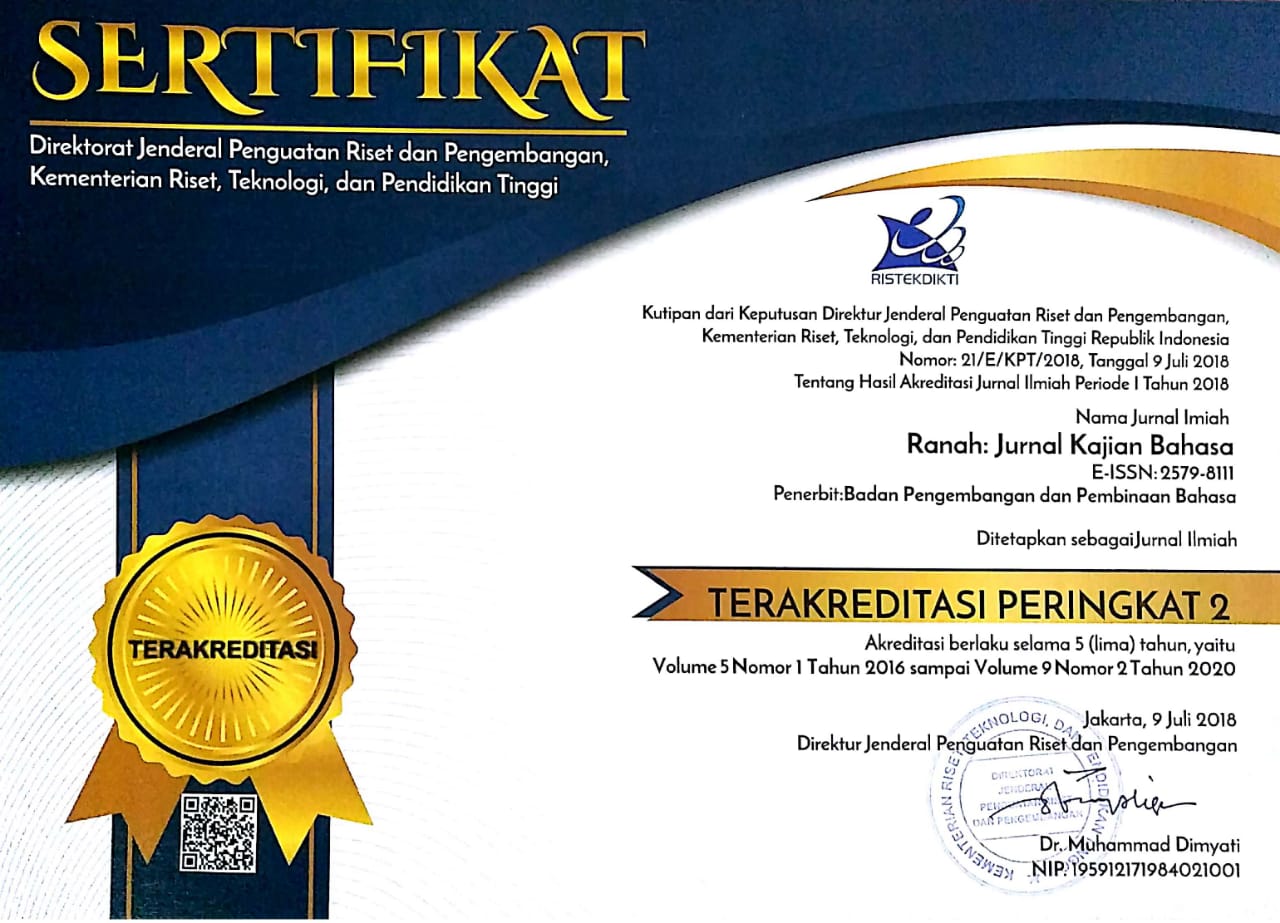Merawat Lagu-lagu Daerah Pagu untuk Pemertahanan Bahasa: Analisis Ekolinguistik
Abstract
This study explores the maintenance of the Pagu language of North Halmahera by caring for the wealth of its literature such as folksongs. The data examined are three Pagu folksongs. The collected data were categorized and interpreted using ecocriticism and related studies particularly in terms of obtaining, presenting, and analyzing them. Using ecolinguistic perspective to analyze the data, the results show that first, all three songs contain cultural values and customs that show the identity of the Pagu community that have to be maintained. Second, ecolinguistic analysis reveals the emotional closeness of the Pagu community with their natural surroundings although nature is sometimes considered to hinder human journey. Third, in terms of distribution, the songs are influenced by Ternate and other regional languages in North Halmahera. Finally, this study concludes interaction among language users and efforts to care for folk songs should continue to prevent the extinction of the Pagu language.
Abstrak
Penelitian ini membahas pemertahanan bahasa Pagu yang dipakai oleh suku Pagu di Halmahera Utara dengan cara merawat kekayaan sastra dalam bahasa tersebut berupa lagu-lagu daerah. Metode deskriptif-kualitatif dipakai untuk menganalisis data berupa tiga lagu daerah Pagu dengan perspektif ekolinguistik. Data yang terkumpul dikelompokkan dan diinterpretasikan dengan perspektif teori ekokritik dan kajian serupa yang memanfaatkan analisis ekolinguistik terutama dalam hal memperoleh, menyajikan, dan menganalisis data. Hasil penelitian menunjukkan bahwa pertama, ketiga lagu mengandung nilai-nilai budaya dan adat-istiadat yang menunjukkan jatidiri masyarakat Pagu yang harus dipertahankan. Kedua, analisis ekolinguistik membuktikan kedekatan emosi masyarakat Pagu dengan alam sekitarnya meskipun kadang alam dianggap sebagai perintang. Ketiga, lagu-lagu tersebut dipengaruhi oleh bahasa Ternate dan bahasa daerah lainnya di Halmahera Utara. Akhirnya disimpulkan bahwa interaksi antar pengguna bahasa dan perawatan budaya seperti lagu-lagu rakyat perlu ditingkatkan agar kepunahan bahasa Pagu dapat dicegah.
Keywords
Full Text:
PDF (Bahasa Indonesia)References
Albury, N. J. (2016). Defining Māori language revitalisation: A project in folk linguistics. Journal of Sociolinguistics. https://doi.org/10.1111/josl.12183
Amal, M. A. (2016). Kepulauan rempah-rempah. Jakarta: Kepustakaan Populer Gramedia.
Brenzinger, M., & Heinrich, P. (2013). The return of Hawaiian: Language networks of the revival movement. Current Issues in Language Planning. https://doi.org/10.1080/14664208.2013.812943
Chala Teresa, G., & Dagim Raga, H. (2018). Oromo Oral Literature for Environmental Conservation: A Study of Selected Folksongs in East and West Hararghe Zones. Humanities, 7(4), 94. https://doi.org/10.3390/h7040094
Eliasson, S. (2015). The birth of language ecology: Interdisciplinary influences in Einar Haugen's "The ecology of language." Language Sciences. 50(2) https://doi.org/10.1016/j.langsci.2015.03.007
Guérin, V. (2008). Writing an endangered language. Language Documentation & Conservation.
Hinton, L. (2001). Language Revitalization. In The Green Book of Language Revitalization in Practice. https://doi.org/10.1016/B978-012349353-8/50003-0
Hinton, L. (2011). Language revitalization and language pedagogy: New teaching and learning strategies. Language and Education. 25(4). https://doi.org/10.1080/09500782-.2011.577220
Hisyam, M., D. Purwoko, Usman, D. P. (2012). Bahasa Pagu: Vitalitas dan Pemertahanannya. Jakarta: PMB-LIPI.
Johnson, H. (2015). Musical ownership and popfolk on Jersey: Sustaining tradition through intervention, technology and creative practice. Journal of World Popular Music. 2(1) https://doi.org/10.1558/jwpm.v2i1.27169
Kingsnorth, P., & Hine, D. (2009). Uncivilized | The Manifesto.
Lauder, M. R. M. T. (2011). Pengelolaan dan Pemberdayaan Bahasa yang Berpotensi Terancam Punah. Prosiding Seminar Pengembangan Dan Perlindungan Bahasa-Kebudayaan Etnik Minoritas Untuk Penguatan Bangsa, Vol 5. https://doi.org/10.21832/9781853598685-007
Lauder, M. R. M. T. (2018). 4. Obstacles to Creating an Inventory of Languages in Indonesia: A Dialectology Perspective. In Language Diversity in the Pacific. https://doi.org/10.21832/9781853598685-007
McCarter, J., & Gavin, M. C. (2011). Perceptions of the value of traditional ecological knowledge to formal school curricula: Opportunities and challenges from Malekula Island, Vanuatu. Journal of Ethnobiology and Ethnomedicine. https://doi.org/10.1186/1746-4269-7-38
McCormick, A. (2016). Vanuatu education policy post-2015: "Alternative", decolonising processes for "development." International Education Journal.
Nash, J. (2015). Placenames and ecolinguistics: Some considerations for toponymists. AAA - Arbeiten Aus Anglistik Und Amerikanistik.
Nash, J., & Mühlhäusler, P. (2014). Linking language and the environment: The case of Norf'k and Norfolk Island. Language Sciences. https://doi.org/10.1016/j.langsci.2013.08.004
Nooteboom, G., & De Jong, E. B. P. (2010). Against "Green Development Fantasies": Resource degradation and the lack of community resistance in the Middle Mahakam Wetlands, East Kalimantan, Indonesia. Asian Journal of Social Science. https://doi.org/10.1163/156853110X490935
Norrick, N. R. (2011). How proverbs mean: Semantic studies in english proverbs. In How Proverbs Mean: Semantic Studies in English Proverbs. https://doi.org/10.2307/415429
Pattikayhatu, J. A. (2012). Bandar Niaga di Perairan Maluku dan Perdagangan Rempah-Rempah Commercial Port in the Moluccas Territorial Water and Spice Trade. Kapata Arkeologi.
Perangin-Angin, D. (2013). Meninjau Struktur Peribahasa Pagu: Sebuah Bahasa di Indonesia Timur yang Terancam Punah. Jurnal Masyarakat Dan Budaya, 15(3), 447-474.
Perangin-Angin, D. M. (2018). A descriptive grammar of the Pagu language. Unpublished PhD Thesis, The University of Hong Kong.
Ririmasse, M. N. (2017). Sebelum Jalur Rempah: Awal Interaksi Niaga Lintas Batas di Maluku dalam Perspektif Arkeologi. Kapata Arkeologi. 13(1) https://doi.org/-10.24832/kapata.v13i1.388
Rosowsky, A. (2015). Heavenly verses: The role of devotional song in minority language maintenance. The Music of Endangered Languages, 92-99.
Steffensen, S. V., & Fill, A. (2014). Ecolinguistics: The state of the art and future horizons. Language Sciences. https://doi.org/10.1016/j.langsci.2013.08.003
Stibbe, A. (2015). Ecolinguistic Discourse Analysis. In The International Encyclopedia of Language and Social Interaction. https://doi.org/10.1002/9781118611463.wbielsi013
Sunarto, E., Mukarto, F. X., Bismoko, J., & Dewi, N. (1998). Trilingual Textualization To Deliver Indonesian Local Cultures to High School Students. Language and Language Teaching Journal. https://doi.org/10.24071/llt.2018.210109
Tondo, F. H. (2019). Language and religion: The use of language in Christian liturgy on some border areas of Indonesia. Jurnal Masyarakat Dan Budaya, 20(3), 347-359. https://doi.org/10.14203/jmb.v20i3.593
Vari-Bogiri, H. (2005). A sociolinguistic survey of Araki: A dying language of Vanuatu. Journal of Multilingual and Multicultural Development. 26(1) https://doi.org/10.1080/14790710508668398
https://doi.org/10.1080/14790710508668398
DOI: https://doi.org/10.26499/rnh.v9i2.2932
Refbacks
- There are currently no refbacks.








